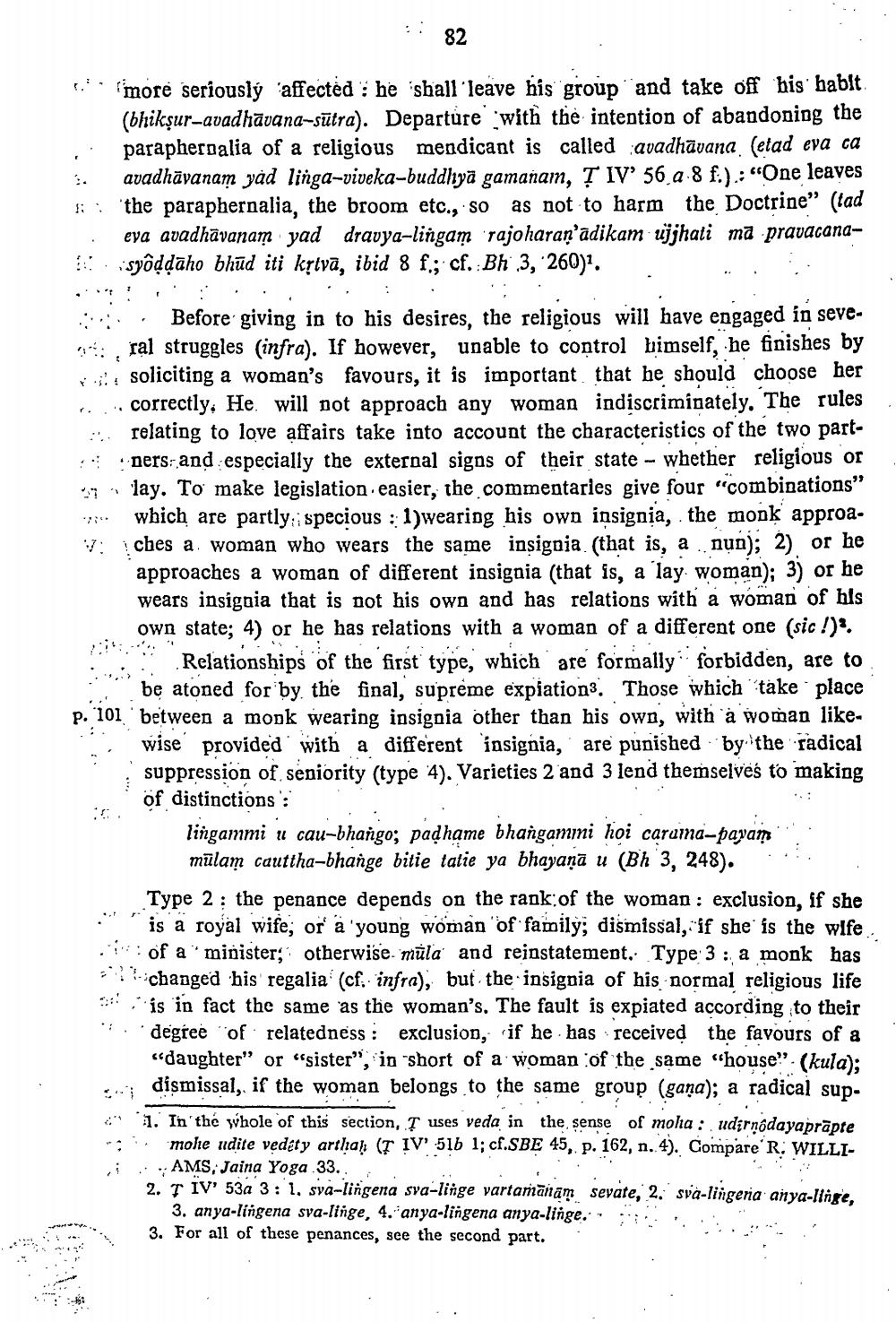________________
:: 82
more seriously affected : he shall leave his group and take off bis habit
(bhikṣur-avadhāvana-sūtra). Departure with the intention of abandoning the ,paraphernalia of a religious mendicant is called avadhavana (etad eva ca 1. avadhāvanam yad linga-viveka-buddhyā gamanam, Ţ IV' 56 a 8 f.).:"One leaves si : the paraphernalia, the broom etc., so as not to harm the Doctrine” (tad
eya avadhavanam yad dravya-lingam rajoharan'adikam ujjhati ma pravacanasyôddāho bhūd iti krtvā, ibid 8 f.; cf. :Bh 3, 260).
Rela
. Before giving in to his desires, the religious will have engaged in seve.: , ral struggles (infra). If however, unable to control bimself, he finishes by tje soliciting a woman's favours, it is important that he should choose her ...... correctly, He will not approach any woman indiscriminately. The rules ... relating to love affairs take into account the characteristics of the two part
ners and especially the external signs of their state - whether religious or
lay. To make legislation easier, the commentaries give four "combinations" apps which are partly, specious :: 1)wearing his own insignia, the monk approa: ches a woman who wears the same insignia. (that is, a nun); 2), or he
approaches a woman of different insignia (that is, a lay woman); 3) or he wears insignia that is not his own and has relations with a woman of his own state; 4) or he has relations with a woman of a different one (sic!).
Relationships of the first' type, which are formally forbidden, are to
be atoned for by the final, supreme expiations. Those which take place p. '101' between a monk wearing insignia other than his own, with a woman like
wise provided with a different insignia, are punished by the radical suppression of seniority (type 4). Varieties 2 and 3 lend themselves to making of distinctions :
lingammi u cau-bhango; padhame bhangammi hoi caruma-payam ..
mūlam cauttha-bhange bitie tatie ya bhayanā u (Bh 3, 248). Type 2: the penance depends on the rank of the woman : exclusion, if she
is a royal wife, or' ä 'young woman of family; dismissal, i-if she is the wife .:: of a minister, otherwisemula and reinstatement. Type 3: a monk has I changed his regalia (cf. infra), but the insignia of his normal religious life
is in fact the same as the woman's. The fault is expiated according to their *7. degree of relatedness i exclusion, if he has received the favours of a
“daughter" or "sister", in short of a woman of the same "house". (kula): S; dismissal, if the woman belongs to the same group (gaña); a radical sup* 1. In the whole of this section, I uses veda in the sense of moha :. udírnodayaprāpte
mohe udite vedety arthah (T IV' 5lb 1; cf.SBE 45, p. 162, n. 4). Compare R. WILLI, .,AMS, Jaina Yoga 33.
2. I IV' 53a 3 : 1. sva-lingena sva-linge vartamānām sevate, 2. sva-lingeria anya-linge,
3. anya-lingena sva-linge, 4. anya-lingena anya-linge.. .. . 3. For all of these penances, see the second part.




